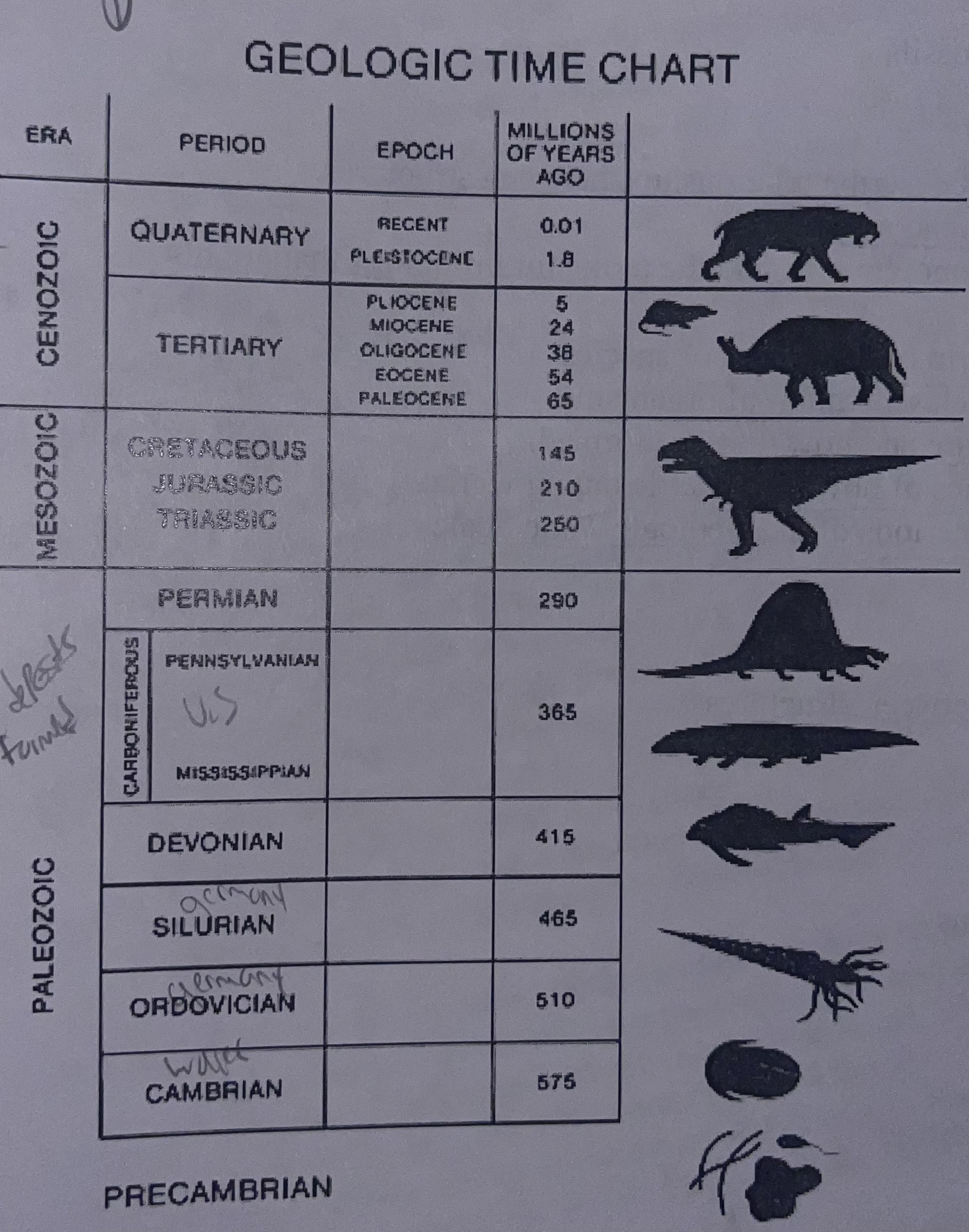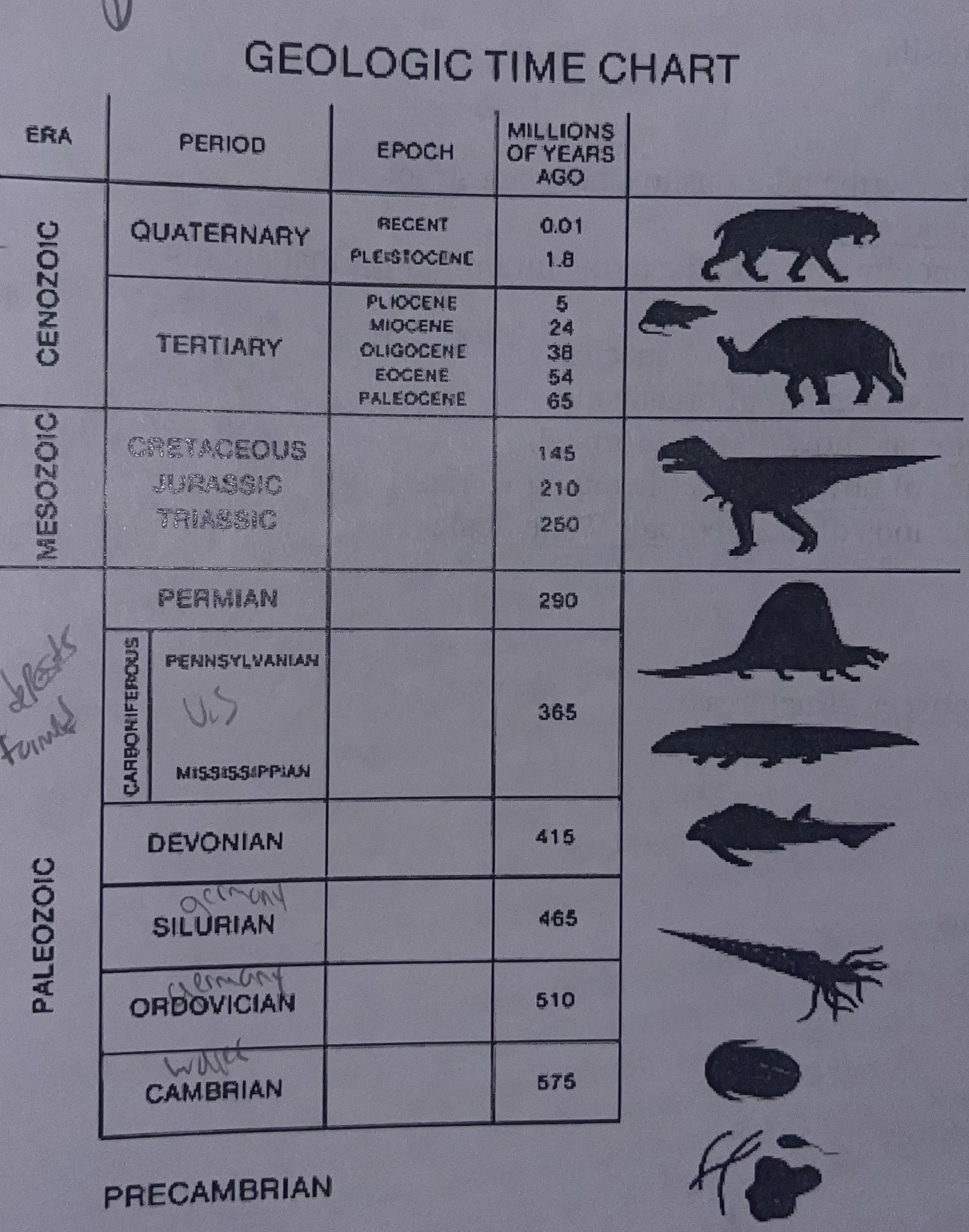comparative anatomy exam 1
1/122
There's no tags or description
Looks like no tags are added yet.
Name | Mastery | Learn | Test | Matching | Spaced |
|---|
No study sessions yet.
123 Terms
comparative anatomy
Study of structure of organisms, with an emphasis on similarities caused by evolutionary relatedness
Anatomy
The study of the structure of organisms and their parts
Morphology
The form of an organism, often used as a synonym for anatomy
Evolution
Genetic change in a pop over time, often used to reference change in structure and function of an organism
Natural selection
Differential survival of different genetic types within a population, theory that describes a mechanism which causes evolutionary change
How natural selection works: Theory of Natural selection
Variation- all populations vary naturally
Overpopulation- all populations produce more offspring than can survive
Competition- resources are limited so competition between species
Differential reproductive success- variation allows some individuals to survive and reproduce better than others
Heritability - favorablehh traits are passed down from generation to generation
Variation
all populations vary naturally
Overpopulation
all populations produce more offspring than can survive
competition
resources are limited so competition between species
Differential reproductive success
variation allows some individuals to survive and reproduce better than others
Heritability
favorable traits are passed down from generation to generation
Fitness
The ability of an organism to get its genes into the next generation
Categories of evidence for natural selection
Direct observation
Homology
Fossil record
Homology
Similarities in anatomy or other genetic traits of a diffrent species due to shared ancestors
Analogy
Similarities if anatomy or other genetic traits of different species due to similar selection pressures rather than common ancestry (convergent evolution)
Pentadactyl
Term which refers to organisms which have five digits on each arm or leg, specifically referring to tetrapods and their immediate ancestors
Tetrapod
monophyletic group which includes all land vertebrates- amphibians, reptiles, crocodilians, turtles, birds and mammals
4 Homology Examples
Homologous structures
Serial Homology
Vestigial organs
Embryology
Serial Homology
Type of Homology in which successive body segments are based on a single plan, like annelids, arthropods, and chordates
Vestigial organs
Body part which no longer serves a function for which it originally evolved
Nicitating membrane
Inner third eyelid of some reptiles, birds, and mammals. Humans have a vestigial third eyelid
Atavism
Structure which has disappear over evolutionary time, but later reappears
Embryology
Division of biology which focuses on the study of embryological development
Fossil
any preserved trace of a long dead organism
Transitional fossil: Archaopteryx lithographica
An extinct bird which shows an evolutionary transition between ancestral dinosaurs and modern bird
Parsimony
The idea that the least complex explanation of those possible is most likely to be correct
Terms that describe relationships between structures
Homology
Analogy
Homoplasy
Homology
Similarities in anatomy or other genetic traits of different species due to shared ancestry
Analogy
Convergent evolution, similarities in anatomy or other genetic traits due to similar selection pressures rather than common ancestry
Homoplasy
Similarities in anatomy or other genetic traits of diffrent species not sure to common ancestry, or similar selection pressures, perhaps due to mimicry, crypsus or random chance
Mimicry
A close, non cryptic resemblance between two or more organisms which gives, one, both, or all an advantage or benefit in their relationship with predators or prey
phylogeny
Evolutionary history of a Taxon or group of taxa
Phylogram (cladogram)
A visual representation of a classification based upon evolutionary relationship
Dendrogram
A branching diagram which illustrates the relationship between taxa, if it is evolutionary history it will still be a phylogram or cladogram
Clade
Taxonomic grouping which contains a common ancestor and all of its descendants (monophyletic)
Paraphyletic
Refers to Taxon which contains an ancestral organisms and some but not all of its descendants
Ex: class reptilia
Monophyletic
Refers to taxa which includes a single common ancestor and all of its descendants (properly constructed clade)
Polyphyletic
Refers to Taxon which does not include the common ancestor of all organism included with it
Sister taxa
Two taxa who split from a common ancestor, on a dendrogram it will be the two branches that emerge from a node
Branch
Line on a dendrogram representing one of two taxa which emerge from the split which occurs at a node
Node
Point on a dendrogram where two taxa separate resulting in two branches
Root
Structures common ancestor
Derived
Relatively new in an evolutionary sense
Primitive
Relatively old in an evolutionary sense
Symplesiomorphic
Refers to structures or traits which are shared by two taxa and relatively primitive
Synapomorphic
Refers to structures which are shared and relatively derived
Carolus Linnaeus
Swedish botanist who devised the system of classification and nomenclature we use today
Kingdom
level of classification between domain and phylum
Phylum
Level of classification between kingdom and class
Class
Level of classification between phylum and order
Order
Level of classification between class and family
Family
Level of classification between order and genus
Genus
Level of classification between family and species
Species
Group of similar organisms which can reproduce successfully within the group but not with organisms outside the group, lowest level of classification
Taxon
Any scientifically named group of an organism
Fossils
Any preserved trace of a previously living organism
Trace fossils
A fossil which is a remnant of a formerly living thing, but dose not include a part of the organism itself
coprolite
Fossilized fecal matter
Sedimentary rock
Rock which is formed by the build up of layers of sediment at the bottom of large bodies of water, where fossils are usually found
Ingenious rock
Rock which is formed from volcanic lava
Radiometric dating
Technique which uses the known half lives of radioactive isotopes to determine the age of rocks and fossils by comparing the amount of the isotope present to the amount of its product
Stratigraphy
Study of rock layers and which fossils occurred in them
Geological time scale
System which divides the history of the earth based on the relative age of rocks in the earths crust and what fossils are found in each layer

Know geological time scale in order

Echinodermata
Phylum if bilateral animals which includes ,sea stars, brittle stars, sea cucumbers, and their relatives. It is related to chordates
Chordata
Phylum which includes animals with a notochord, pharyngeal slits, endostyle, dorsal hallow nerve cord, and a post anal tail. Phylum is divided into three subphylum’s, Urochordata, cephalochordata and vertebrata
Protochordate
An informal, paraphyletic grouping which includes hemichordates, urochordates, and cephalochordates
Hemichordata
Phylum of animals which includes acorn worms, are considered close relatives of chordates because they have:
Pharyngeal slits, and a dorsal nerve cord but lack a notochord and post anal tail
Filter feeders who live in sediment of marine habitats
Acorn worm
Common name for members in phylum hemichordata
Urochordata
Subphylum of phylum chordata that includes tunicates
Tunicates
Animal which is a member of subphylum urochordata
They are bottom dwelling, filter feeding organisms found in marine habitats.
They develop from a tadpole larva which have all the characteristics of chordates but undergo metamorphosis into adults who are sessile filter feeders which pump water through a mucus covered basket.
Sea squirt
Common name for tunicates in class Ascidacea
Ascidacea
Class within subphylum Urochordata which includes the most common tunicates called sea squirts
Tunic
The tough outer body covering of an adult tunicate
Cephalochordata
Subphylum of phylum chordata that includes lancelets (amphioxous)
Amphioxus
Informal common name for lancdlets in the subphylum cephalochordata.
Pikaia gracilens
Extinct fossil member of the subphylum Cephalochordata. It is one of the earliest known chordates. It was discovered in the Burgess Shale of Canada
Vertebrata
Subphylum of phylum Chordata that includes all animals with a bony or cartilaginous endoskeleton. Sometimes referred to as craniata
Know the 5 chordate characteristics
Notochord
Dorsal hallow nerve cord
Post anal tail
Pharyngeal slits
Endostyle
Notochord
A cartilaginous rod which runs the length of the dorsal side of the body of members of phylum Chordata.
The notochord is used for attachment of muscles which allow chordates to use their post anal tail for swimming
Nerve cord
A large nerve which runs the length of the dorsal side of the body of members of phylum Chordata. The chord is hollow, and in vertebrates, the anterior end everts during embryological development to become the brain
Endostyle
A longitudinal ciliated groove on the central wall of the pharynx which produces mucus to gather food particles.
It is found in urochordates, cephalochordates, and some vertebrate larvae, and is homologous to the thyroid gland in more derived vertebrates
Thyroid gland
An endocrine gland found in most adult vertebrates which is a major control gland for metabolism. It is homologous to the endostyle
Pharyngeal slits
Openings found in the pharynx of members of phylum Chordata. The openings allow filter feeding in some members of the group, and are used as gill slits in some more derived members
Post anal tail
A muscular tail that extends past the anal opening, found in members of phylum Chordata. Makes chordates strong swimmers compared to most invertebrates.
Myomere
One of the segmented muscle blocks found in the vertebrate body.
Padeomorphis
The retention of larval characteristics in sexually mature animals
Know the three hypothesis for the evolutionary origin of chordates
inverted arthropods
Echinoderm derivation
Echinoderm-cephalochordate derivation
Inverted arthropod hypothesis
Idea that Arthropods simply flipped over and dorsal became ventral
Echinoderm Derivation
Idea that the Larva of echinoderms who have similar characteristics to chordates, underwent padeomorphosis and reproduced
Echinoderm- cephalochordate derivation
Idea that the Common ancestors of chordates split from echinoderms and hemichordates and at some point flipped over
Bilateria
clade of animals within kingdom Animalia which includes all animals with bilateral symmetry. Includes all animals except sponges, cnidarians, placozoans, and ctenophores
Bilateral symmetry
A type of symmetry in which a single plane (the sagital plane) can be used to divide an animal into mirror image left and right sides. Bilateral animals also have an anterior and posterior end and a dorsal and ventral surface
Coelomate
Any animal which has a coleum, a body cavity which contains and allows movement of internal organs, especially the digestive tract
Deuterostome
Any clade of animals within the bilateria which have a pattern of embryological development in which the first opening in the blastula becomes the anus and the second opening becomes the mouth.
this group includes chordates, hemichordates, and echinoderms
Protostome
Any clade of animals within the Bilateria which have a pattern of embryological development where the first opening in the blastula becomes the mouth and the second becomes the anus.
This group included the arthropods, mollusks, nematodes, annelids, tardigrades, and many other vertebrates
Diplerula
Hypothetical larva like common ancestor of all dueterostomes
Vertebra
Any of a series of bones which make up the spinal column of vertebrates
Craniata
Alternate name for subphylum Vertebrata
Cranium
The set of bones which supports and surrounds the brain of vertebrates.